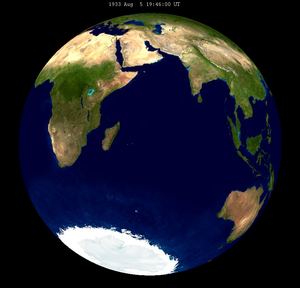August 1933 lunar eclipse
| Penumbral eclipse | |||||||||
 The Moon's hourly motion shown right to left | |||||||||
| Date | August 5, 1933 | ||||||||
|---|---|---|---|---|---|---|---|---|---|
| Gamma | −1.4216 | ||||||||
| Magnitude | −0.7336 | ||||||||
| Saros cycle | 108 (70 of 72) | ||||||||
| Penumbral | 129 minutes, 33 seconds | ||||||||
| |||||||||
A penumbral lunar eclipse occurred at the Moon’s ascending node of orbit on Saturday, August 5, 1933,[1] with an umbral magnitude of −0.7336. A lunar eclipse occurs when the Moon moves into the Earth's shadow, causing the Moon to be darkened. A penumbral lunar eclipse occurs when part or all of the Moon's near side passes into the Earth's penumbra. Unlike a solar eclipse, which can only be viewed from a relatively small area of the world, a lunar eclipse may be viewed from anywhere on the night side of Earth. Occurring about 2.1 days after perigee (on August 3, 1933, at 17:40 UTC), the Moon's apparent diameter was larger.[2]
This eclipse was the third of four penumbral lunar eclipses in 1933, with the others occurring on February 10, March 12, and September 4.
Visibility
[edit]The eclipse was completely visible over much of Africa, eastern Europe, much of Asia, Australia, and Antarctica, seen rising over western Europe, west Africa, and eastern Brazil and setting over northeast Asia and the western Pacific Ocean.[3]
 
|
Eclipse details
[edit]Shown below is a table displaying details about this particular solar eclipse. It describes various parameters pertaining to this eclipse.[4]
| Parameter | Value |
|---|---|
| Penumbral Magnitude | 0.23237 |
| Umbral Magnitude | −0.73362 |
| Gamma | −1.42163 |
| Sun Right Ascension | 09h01m27.7s |
| Sun Declination | +16°56'57.5" |
| Sun Semi-Diameter | 15'46.2" |
| Sun Equatorial Horizontal Parallax | 08.7" |
| Moon Right Ascension | 21h03m41.4s |
| Moon Declination | -18°15'57.4" |
| Moon Semi-Diameter | 16'19.5" |
| Moon Equatorial Horizontal Parallax | 0°59'54.8" |
| ΔT | 23.9 s |
Eclipse season
[edit]This eclipse is part of an eclipse season, a period, roughly every six months, when eclipses occur. Only two (or occasionally three) eclipse seasons occur each year, and each season lasts about 35 days and repeats just short of six months (173 days) later; thus two full eclipse seasons always occur each year. Either two or three eclipses happen each eclipse season. In the sequence below, each eclipse is separated by a fortnight. The first and last eclipse in this sequence is separated by one synodic month.
| August 5 Ascending node (full moon) |
August 21 Descending node (new moon) |
September 4 Ascending node (full moon) |
|---|---|---|
 |
 |

|
| Penumbral lunar eclipse Lunar Saros 108 |
Annular solar eclipse Solar Saros 134 |
Penumbral lunar eclipse Lunar Saros 146 |
Related eclipses
[edit]Eclipses in 1933
[edit]- A penumbral lunar eclipse on February 10.
- An annular solar eclipse on February 24.
- A penumbral lunar eclipse on March 12.
- A penumbral lunar eclipse on August 5.
- An annular solar eclipse on August 21.
- A penumbral lunar eclipse on September 4.
Metonic
[edit]- Followed by: Lunar eclipse of May 25, 1937
Tzolkinex
[edit]- Preceded by: Lunar eclipse of June 25, 1926
Half-Saros
[edit]- Preceded by: Solar eclipse of July 31, 1924
- Followed by: Solar eclipse of August 12, 1942
Tritos
[edit]- Followed by: Lunar eclipse of July 6, 1944
Lunar Saros 108
[edit]- Preceded by: Lunar eclipse of July 26, 1915
- Followed by: Lunar eclipse of August 17, 1951
Inex
[edit]- Followed by: Lunar eclipse of July 17, 1962
Triad
[edit]- Preceded by: Lunar eclipse of October 4, 1846
- Followed by: Lunar eclipse of June 5, 2020
Lunar eclipses of 1933–1936
[edit]| Descending node | Ascending node | |||||
|---|---|---|---|---|---|---|
| Saros | Date Viewing |
Type Chart |
Saros | Date Viewing |
Type Chart | |
| 103 | 1933 Feb 10
|
Penumbral
|
108 | 1933 Aug 05
|
Penumbral
| |
| 113 | 1934 Jan 30
|
Partial
|
118 | 1934 Jul 26
|
Partial
| |
| 123 | 1935 Jan 19
|
Total
|
128 | 1935 Jul 16
|
Total
| |
| 133 | 1936 Jan 08
|
Total
|
138 | 1936 Jul 04
|
Partial
| |
| 143 | 1936 Dec 28
|
Penumbral
| ||||
Half-Saros cycle
[edit]A lunar eclipse will be preceded and followed by solar eclipses by 9 years and 5.5 days (a half saros).[5] This lunar eclipse is related to two total solar eclipses of Solar Saros 115.
| July 31, 1924 | August 12, 1942 |
|---|---|

|

|
See also
[edit]Notes
[edit]- ^ "August 5–6, 1933 Penumbral Lunar Eclipse". timeanddate. Retrieved 16 December 2024.
- ^ "Moon Distances for London, United Kingdom, England". timeanddate. Retrieved 16 December 2024.
- ^ "Penumbral Lunar Eclipse of 1933 Aug 05" (PDF). NASA. Retrieved 16 December 2024.
- ^ "Penumbral Lunar Eclipse of 1933 Aug 05". EclipseWise.com. Retrieved 16 December 2024.
- ^ Mathematical Astronomy Morsels, Jean Meeus, p.110, Chapter 18, The half-saros
External links
[edit]- 1933 Aug 05 chart Eclipse Predictions by Fred Espenak, NASA/GSFC



